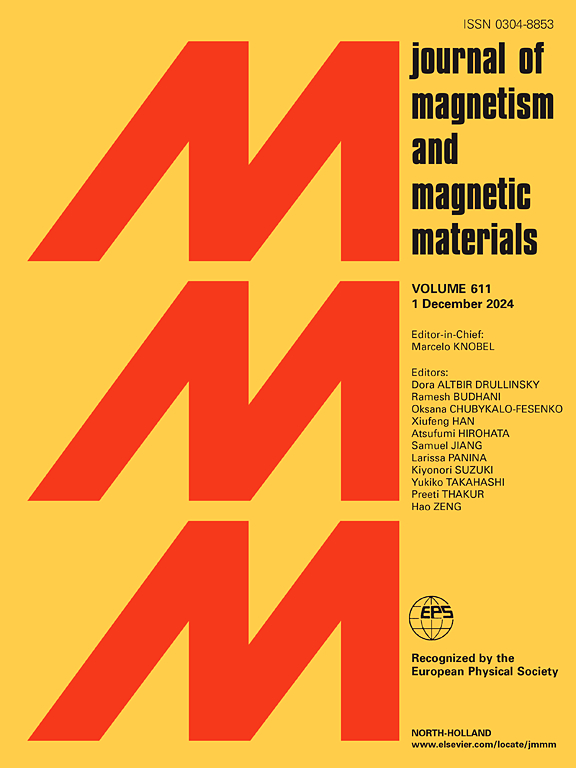New effective field theory in a cluster with n-sites correlating with n-free spins: Ferrimagnetic and Antiferromagnetic
IF 2.5
3区 材料科学
Q3 MATERIALS SCIENCE, MULTIDISCIPLINARY
引用次数: 0
Abstract
The Ising model is a central tool in the study of spin systems, with various generalizations to describe complex magnetic orderings. This work proposes a new application of the effective field theory (EFT) using clusters with -sites, extending previous approaches to ferrimagnetic and antiferromagnetic states. Two specific cases are analyzed: a three-layer system of triangular lattices for ferrimagnetism and a square lattice for antiferromagnetism. The results include magnetizations, magnetic susceptibilities, and phase diagrams, showing that increasing the number of sites in the cluster improves accuracy, bringing the values closer to those obtained from Monte Carlo simulations. The proposed approach offers an efficient tool to study magnetic systems with different couplings and structural configurations. Although the new method presents improvements in numerical results, it is important to emphasize that its main contribution lies in introducing a more efficient approach, with simplifications in mathematical expansions aimed at reducing the computational time required in studies of this nature.
与n-自由自旋相关的n位团簇的新有效场论:铁磁和反铁磁
伊辛模型是研究自旋系统的核心工具,有各种各样的概括来描述复杂的磁有序。本文提出了一种利用n位簇的有效场论(EFT)的新应用,将以前的方法扩展到铁磁和反铁磁状态。分析了两种具体情况:铁磁性的三层三角形晶格系统和反铁磁性的方形晶格系统。结果包括磁化、磁化率和相图,表明增加簇中位点的数量可以提高精度,使数值更接近蒙特卡罗模拟得到的结果。该方法为研究具有不同耦合和结构构型的磁系统提供了一种有效的工具。尽管新方法在数值结果上有所改进,但重要的是要强调,它的主要贡献在于引入了一种更有效的方法,简化了数学展开,旨在减少这种性质的研究所需的计算时间。
本文章由计算机程序翻译,如有差异,请以英文原文为准。
求助全文
约1分钟内获得全文
求助全文
来源期刊

Journal of Magnetism and Magnetic Materials
物理-材料科学:综合
CiteScore
5.30
自引率
11.10%
发文量
1149
审稿时长
59 days
期刊介绍:
The Journal of Magnetism and Magnetic Materials provides an important forum for the disclosure and discussion of original contributions covering the whole spectrum of topics, from basic magnetism to the technology and applications of magnetic materials. The journal encourages greater interaction between the basic and applied sub-disciplines of magnetism with comprehensive review articles, in addition to full-length contributions. In addition, other categories of contributions are welcome, including Critical Focused issues, Current Perspectives and Outreach to the General Public.
Main Categories:
Full-length articles:
Technically original research documents that report results of value to the communities that comprise the journal audience. The link between chemical, structural and microstructural properties on the one hand and magnetic properties on the other hand are encouraged.
In addition to general topics covering all areas of magnetism and magnetic materials, the full-length articles also include three sub-sections, focusing on Nanomagnetism, Spintronics and Applications.
The sub-section on Nanomagnetism contains articles on magnetic nanoparticles, nanowires, thin films, 2D materials and other nanoscale magnetic materials and their applications.
The sub-section on Spintronics contains articles on magnetoresistance, magnetoimpedance, magneto-optical phenomena, Micro-Electro-Mechanical Systems (MEMS), and other topics related to spin current control and magneto-transport phenomena. The sub-section on Applications display papers that focus on applications of magnetic materials. The applications need to show a connection to magnetism.
Review articles:
Review articles organize, clarify, and summarize existing major works in the areas covered by the Journal and provide comprehensive citations to the full spectrum of relevant literature.
 求助内容:
求助内容: 应助结果提醒方式:
应助结果提醒方式:


